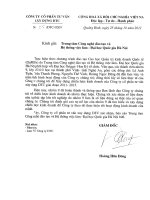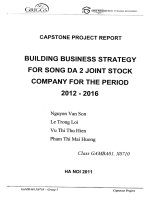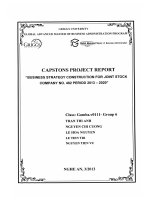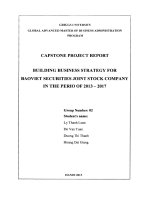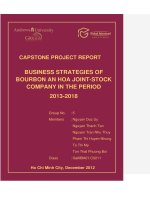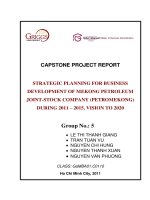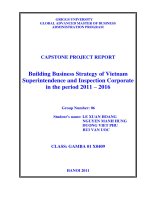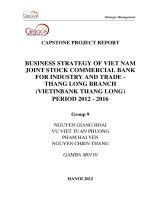Building business strategy of Tien Dong joint stock company for the period 2013 - 2017
Bạn đang xem bản rút gọn của tài liệu. Xem và tải ngay bản đầy đủ của tài liệu tại đây (839.62 KB, 94 trang )
BUILDING BUSINESS STRATEGY OF TIEN DONG
JOINT STOCK COMPANY
FOR THE PERIOD 2013 -2017
CAPSTONE PROJECT REPORT
Ho Chi Minh City
Group 05:
Nguyen Dinh Dai
Nguyen Thi Kieu Nga
Do Le Nhan
Tran Thanh Phong
Pham Truong Son
Class: GaMBA.M0311
Master training program of International Business Administration
1
TABLE OF CONTENTS
CONTENT
TABLE OF CONTENTS
LIST OF TABLES
ABSTRACT
1. The urgency of the thesis
2. The research object and scope
3. Research Methodology
4. Structure of the subject
CHAPTER1THEORETICAL BASIS OF DEVELOPING BUSINESS
STRATEGY OF ENTERPRISES
1.1. Business strategy and its role in enterprises
1.1.1. Definition.
1.1.2. Roles of business strategy.
1.2.Procedures of strategy building.
1.3. Strategic vision and mission
1.4. External environment analysis
1.4.1 Macroeconomic environment analysis
1.4.1.1. Political – Legal factor
1.4.1.2. Economic factor
1.4.1.3. Socio-cultural factor
1.4.1.4. Technological factors
1.4.2 Analysis of industry environment: Analysis of five competitive force
model of Michael Porter
1.4.2.1. Potential competitors:
1.4.2.2. Current competitors:
1.4.2.3. Customers
1.4.2.4. Suppliers
1.4.2.5. Substitute products
1.5. Analysis of internal environment of the company
1.5.1 Resources
1.5.2. Financial capability
PAGE
1
5
6
6
6
7
7
8
8
8
9
10
11
11
11
11
11
12
12
12
13
15
17
17
18
18
18
19
Master training program of International Business Administration
2
1.5.3 Business administration
1.5.4 Core competencies
1.6. Selection of business plan and strategy
1.6.1 Tools of strategy building
1.6.1.1 Matrix of External Factor Evaluation EFE
1.6.1.2 Matrix of Internal Factor Evaluation (IFE)
1.6.1.3. Matrix of Competitive image.
1.6.1.4. SWOT Matrix
1.6.2 Selection of business strategy
1.6.2.1. QSPM Matrix
CHAPTER 2: ANALYSIS OF BUSINESS ENVIRONMENT OF TIEN
DONG JOINT STOCK COMPANY
2.1 Overview of Tien Dong Joint Stock Company.
2.1.1. Establishment and development history of Tien Dong JSC.
2.1.2. Organizational structure and operational feature of company
2.1.3. Vision.
2.1.4. Main business lines.
2.2. External environmental analysis of Tien Dong Joint Stock
Company.
2.2.1. Macro environmental analysis
2.2.1.1. Political factors and the law
2.2.1.2. Economics Factor
2.2.1.3. Sociocultrural Factor
2.2.1.4. Technological Factor
2.2.1.5. Analysis the impact of the integration factor
2.2.2. Analysis of the industry environment of five competitive force model
of Michael Porter
2.2.2.1 Competitiveness of competitors in the industry
2.2.2.2 Competitive pressure of potential competitiors
2.2.2.3. Customer pressure
19
19
20
20
21
22
22
25
27
27
29
29
29
31
32
33
38
38
38
39
42
43
44
45
45
49
50
Master training program of International Business Administration
3
2.2.2.4. Pressure of suppliers
2.2.2.5. Pressure from substitute products
2.2.3. Evaluation of the impacts of the external environment to Tien Dong
Company
2.2.3.1. Evaluation summary of the opportunities and challenges
2.2.3.2. Matrix of External Factor Evaluation (EFE)
2.3 Analysis of internal factors of Tien Dong Joint Stock Company
2.3.1. Analyzing sources of Tien Dong Joint Stock company
2.3.1.1.Financial capacity
2.3.1.2. Human resources and management level
2.3.1.3. Analyzing sources bringing the brand of Tien Dong
2.3.1.4. Tien Dong investment items
2.3.2. Analyzing core competencies of Tien Dong Company
2.3.3. Internal factorEvaluation matrix of Tien Dong Company
2.3.3.1. Total strengths and weaknesses of Tien Dong Company
2.3.3.2. Internal factorEvaluation matrix (IFE matrix)
CHAPTER 3: BUSINESS STRATEGY SELECTION OF TIEN
DONG COMPANY IN THE PERIOD 2013 - 2017
3.1 Objectives of Tien Dong Company in the period 2013 - 2017.
3.1.1. Objectives and mission of Tien Dong Company
3.1.2. Main economic indicators in five years from 2013 to 2017
3.1.3. Business structure
3.1.4. Major tasks.
3.2. Strategic plan of Tien Dong Company in the period 2013 - 2017
3.2.1. SWOT analysis matrix of Tien Dong
3.2.2. Strategic choices.
3.2.2.1. Quantified strategic planning matrix (QSPM)
3.2.2.2. Tine Dong strategic choices in the period 2013 - 2017
3.2.2.3. Content of the choosen strategy
3.2.2.4. Roadmap of strategy deployment:
50
50
51
51
52
55
55
55
57
58
59
60
63
63
64
66
66
66
66
66
67
68
68
71
71
75
75
78
Master training program of International Business Administration
4
3.3. Strategic Solutions
3.3.1. Marketing strategy selection (Marketing Mix – 4P)
3.3.2. Financial Solution
3.3.3. Solution of product quality management
3.3.4. Solution of building and developing human resources
CONCLUSION
REFERENCES
APEPENDIX
78
78
82
83
85
90
91
92
Master training program of International Business Administration
5
LIST OF TABLES AND DIAGRAMS
Order
Name of tables and figurees
Page
Figure 1.1
Map of procedures for strategy building
10
Figure 1.2
Five competitive force model of M. Porter
13
Figure 1.3
Tool model of strategy building
20
Table 1.1
Competition Profile Matrix
24
Table 1.2
SWOT matrix
25
Table 1.3
QSPM matrix
28
Figure 2.1
Organizational layout of Tien Dong Joint Stock Company
31
Table 2.1
Product lines of paint, wall putty of JAVITEX brands Of Tien
Dong company
34
Table 2.2
The proportion of each product line in total revenue
36
Table 2.3
The economy of Vietnam (Source: Data from the General
Statistics Office)
39
Table 2.4
Population in 2009 according to the local area
42
Table 2.5
Summary the comparative advantages of Tien Dong Co with
LIONS and MYCOLOUR
46
Table 2.6
Competitive matrix image
48
Table 2.7
Summary of the opportunities and threaten.
51
Table2.8
Evaluate the intensity of the 5 pressures according to
Michael Porter model to Tien Dong Company
52
Table 2.9
EFE matrix
53
Table 2.10
Indicators of financial capacity of Tien Some Dong
55
Table2.11
Staff’s qualifications
57
Table2.12
Some basic information about
the three high quality paint brands and Javitex
61
Table2.13
Total strengths and weaknesses of Tien Dong Company
63
Table2.14
IFE Matrix
64
Table3.1
Financial targets for five years from 2013 to 2017
66
Table 3.2
Results of SWOT analysis matrix
68
Table3.3
QSPM matrix analysis
71
Table 3.4
Results of QSPM matrix analysis
75
Table3.5
Communication activities
82
Master training program of International Business Administration
6
ABSTRACT
1. The urgency of the thesis
It would be very dangerous if an athlete ran a marathon without estimating his
marathon race and then his running ability is only for 5,000 meters while the race is
10,000 meters. He uses up all his energy for the first 2,000 meters and then could not
drag his feet. In contrast, a miner can get precious minerals when there is only a few feet
underground. However, he cannot know how long he can reach to the point of minerals,
and his physical exhaustion, and depression make him abandon the mining, then embrace
failure without understanding the reason. Now, these stories are also true to an
organization, they must answer the questions “How is the enterprise in the next five
years, ten years? Where is it going? What can it bring to the society?” How to make
sure to meet the expectations of members of the enterprise as well as the society, etc. The
operating way “after doing then thinking the next step” is one of the basic causes of
enterprise failure in doing business.
The fact proves that if it cannot be determined a proper development strategy,
business managers are likely to work themselves into the pitfalls and cannot withdraw
that leading to the business performance decline and even bankruptcy. Enterprises can set
goals and decide to invest in a new field in the hope of development, but due to not
judging all the competitors, their potentials, etc which can lead them to losses. Causes of
failing for enterprises are increasing, either explicit or implicit. For some cases,
enterprises do not have a logical organizational structure, some have ineffective human
resource management, or their management costs are too high. The business product is
not innovated, their market share is more and more declining. They do not use strategies
on price and marketing, etc. Doing business without a business strategy is like building a
big construction works without a design. Therefore, in order to survive and grow,
enterprises need to build themselves a medium and long-term business strategy. It might
be said that the business strategy is indispensable in business management of enterprises.
2. The research object and scope
Tien Dong Joint Stock Company is an enterprise engaged in manufacture and
trading of paints, mainly wall-paint, also known as paint for construction (ACRYNIC
paint line) branded JAVITEX. The goal of the company is to build "JAVITEX" brand
to become a strong brand in the domestic market. Implement all the obligations to the
Master training program of International Business Administration
7
State. Stabilize and improve the quality of life for workers in the Enterprise. Ensure
dividends to shareholders.
Therefore research will focus on the analysis of the business environment, forming
alternatives and selecting business strategy of Tien Dong Joint Stock Company for the
coming years.
3. Research Methodology
On the basis of primary and secondary data collection, direct survey methods,
statistical methods and economic analysis, the SWOT matrix group, EFE matrix; IFE;
QSPM to analyze, evaluate and select business strategies for Tien Dong Joint Stock
Company in order to achieve its objectives.
4. Structure of the subject
In addition to Introduction and Summary, the content of the Subject has 3 chapters
as follows:
Chapter 1. THEORETICAL BASIS OF DEVELOPING BUSINESS
STRATEGY OF ENTERPRISES
Chapter 2. ANALYSIS OF BUSINESS ENVIRONMENT OF TIEN DONG
JOINT STOCK COMPANY
Chapter 3. SELECTION OF BUSINESS STRATEGY OF TIEN DONG
JOINT STOCK COMPANY IN THE PERIOD 2013 - 2017
Master training program of International Business Administration
8
Chapter 1
THEORETICAL BASIS OF DEVELOPING BUSINESS
STRATEGY OF ENTERPRISES
1.1. Business strategy and its role in enterprises
1.1.1. Definition
There are many definitions on business strategy. Approaching in any way, the
nature of the business strategy is to draft future images of an enterprise in its
performance and operation capacity. In this case, the term – business strategy is
established on the three most common meanings:
- Establishing long-term goals of an enterprise;
- Setting out general action programs;
- Selecting action plans, allocating resources to carry out such goals.
(Course book on Strategic Management of National Economics University).
1.1.2. Roles of business strategy
Business strategy plays an important role for the existence and development of each
enterprise. Right business strategy will lead to a good direction for the enterprise. The
business strategy can be considered as a compass for leading the enterprise to the right
direction.
In facts, thanks to proper business strategy, many businessmen achieve success,
defeating their competitors and creating a firm foothold in the market. The business
strategy brings many benefits for the enterprise as follows:
The business strategy helps the enterprise to orient its future activities through the
analysis and forecast of business environment. Business is an activity that is always
affected by both internal and external factors. The business strategy makes the enterprise
flexible and initiative to adapt to market changes, as well as ensures that the enterprise
operates and develops in the right direction. Thus, the enterprise will strive to achieve the
The business strategy helps the enterprise get opportunities and risks for the
development of corporate resources. It supports the enterprise to exploit and use the
resources properly, promoting the strengths of the enterprise.
Master training program of International Business Administration
9
Strategy creates an operating orbit of the enterprise for connecting individuals with
different interests towards a common goal in order to develop the enterprise. Strategy
links the employees together or managers and employees, hereby, strengthening and
improving the enterprise‟s internal resources.
Business strategy is an effective competition tool of business. Context of
globalization and economic integration makes the influence and mutually dependence
between business enterprises. The process has created fierce competition among
enterprises on the market. In addition to competitive factors such as price, quality,
advertising, marketing, the enterprise use business strategy as an effective competition
tool.
1.2. Procedures of strategy building
The strategy is the result of a planning process from the senior management of the
enterprise. Consideration of the planning process is as a starting point. The strategic
planning process can be divided into the following main steps:
- Selection of the mission and the main goals of the enterprise;
- Analysis of the external environment to identify opportunities and challenges of
the business;
- Analysis of the internal environment of the enterprise to point out the strengths
and weaknesses of the enterprise;
- Selection of the strategy based on the resources, capabilities and core
competencies, develop to neutralize the risk, take advantage of opportunities from the
external environment;
- Implementation of strategy: analysis of internal and external environment of the
enterprise, then choice of the strategy is generally considered as building strategy.
Implementation of strategy will include designing organizational structures and
appropriate control systems to put the strategy into practice.
Figure 1.1. Map of procedures for strategy building
Strategic functions, duties and goals of the
enterprise (1)
Analysis of internal
enterprise (S,W) (3)
Analysis of business
environment (OT) (2)
Strategy selection (4)
Master training program of International Business Administration
10
1.3. Strategic vision and mission
The main objectives of the business are to determine what the enterprise hopes to
meet in long term time.
- Strategic vision refers to the future business direction of the enterprise "Where are
we going"
+ The need- to- be pursued market;
+ The focus in the future on the technology-product-customer;
+ Type of company leaders are trying to create.
- Given the strategic mission refers reason for existence and mission of the
enterprise. The mission statement of most companies focus on current business activities
"Who we are and what we do"
+ The current products and services;
+ Served customers‟ demand;
+ Business and technology capacity.
1.4. External environment analysis
1.4.1. Macroeconomic environment analysis
The objective of external analysis is the awareness of opportunities and threats from
the external environment of the enterprise including consideration of the legal factors,
macroeconomic, social culture and technology which can affect the enterprise. Using
Master training program of International Business Administration
11
PEST model is to analyze the impact of the macro environment to Tien Dong Company
according to factor groups.
1.4.1.1. Political – Legal factor
The law, political factors have influence on all the business of a territory, the
institutional factors, the law may endanger the viability and development of any industry.
When trading on an administrative region, the business will be required to comply with
the institutional factor of the law in that area.
1.4.1.2. Economic factor
Economic factors have a direct effect on the potential attraction of different
strategies. The influential economic factors are economic growth, inflation, business
cycles, the increase or decrease in interest rates, the stock market, the increase in GDP,
the tax system and the tax rate.
1.4.1.3. Socio-cultural factor
Each country or territory has its cultural values and specific social factors.
Enterprises need to consider cultural factors to take advantage of the opportunities as
well as affects on the business strategy. Enterprises need to consider the social factors in
market research, social factors such as lifestyle, income, demography, psychology,
education The changes of factors will affect important decisions about products,
services, markets and consumers.
1.4.1.4. Technological factors
Today's advanced technology can be seen as an opportunity as well as threat to
enterprises when building business strategy. The development in the field of information
technology, communication, transportation shortens the geographical distance,
transmission media. The factor includes transport infrastructure development,
infrastructure, research, science and technology applications. The impact of information
technology, internet to business.
In addition, the companies need to be aware of the impacts of natural factors on the
business decisions of a company.
1.4.2. Analysis of industry environment
Five competitive forces model of Michael Porter is considered as an useful and
effective tool to study, analyze competition pressure on the companies.
Master training program of International Business Administration
12
According to M. Porter there are 5 forces orient the competition within the industry,
which are:
(1) threat of new entrants.
(2) Intensity of competitive rivalry.
(3) the bargaining power of buyers.
(4) bargaining power of the seller.
(5) threat of substitute products.
The task for the administrators is to be aware of the opportunities and threats
created by the change of forces, thereby to develop adaptation strategies.
Figure 1.2. Five competitive force model of M. Porter
According to Michael Porter, the intensity of competition in any industry is affected
by the following five competitive forces:
1.4.2.1. Threats of potential competitors:
Potential competitors consist of the companies involved in the industry, who have
unclear competitiveness at present but competitive potential and power in the future.
With the desire to gain market share the competitors are willing to invest into new
Potential
competitors
Current
competitors
The
Company
Competition
between existing
firms in the
industry
Threat of
having
competitors
Customers
Suppliers
Substitute
product
Ability to
pressure of
customers
Ability to
pressure of
customers
Threat of
substitute
products
Master training program of International Business Administration
13
technologies to exploit. Companies should consider the threat due to the entry possibility
of these potential competitors.
This force includes the companies currently is not competitive in the industry, but
they are able to do it if they want.
The higher the cost for joining the industry of new companies is, the higher the
barriers to entry are. High barriers to entry will keep potential competitors outside even
when the income in the industry is high.
Economist Joe Bain, identifies three sources of barriers to entry including: brand
loyalty;absolute cost advantage and Economy of scale. In addition to the Bain‟s factors,
we can add two important barriers worth considering in many cases. They are: switching
costs, government regulations and retaliation
- Brand loyalty: The buyer's favorite for the products of the existing companies
now is called brand loyalty. Brand loyalty will cause difficulties for entrants to gain the
market share of existing companies. Therefore, it reduces the entry threat of potential
competitors; the competitors find that task of dispelling customer‟s favorite established is
extremely difficult and costly.
- Absolute cost advantage: the existing companies can have the absolute advantage
in cost compared to those who enter the contest. Such absolute advantages in costs come
from:
+ Preponderant operation thanks to experiences
+ The control of special inputs for production such as labor, materials, equipment,
and management skills.
+ Access to cheaper capital because the existing company is at risk lower than the
company that has not been established.
If the company is in the absolute cost advantage, the threat from beginternals drops.
- Economies of scale: Economies of scale is the marginal efficiency improvement
because the enterprise accumulated experience with increases in its size. The sources of
economies of scale includes cost lower through mass production or standardized large
amounts of products, discount for big purchase of materials, advantages is obtained by
the allocation of fixed costs for large volume production, and the economics of scale in
advertising. Once the cost advantage is significant in the industry, newcomers must be in
Master training program of International Business Administration
14
a situation, or to begin with the small-scale and leave the cost advantage, or to accept the
risk to enter with the large-scale and large capital expense.
- Conversion cost: Conversion cost is the once – paying cost when customers want
to convert their purchases to another suppliers. The conversion cost may be related to the
cost of procurement of equipment, staff training costs, even the consumption of spirits in
case of ending a relationship.
If conversion cost is high, customers are restrained in the current company's
products even if the products of the newcomers are better.
1.4.2.2. Risk of current competitors:
In the model of Michael Porter, existing competitors have already had a strong
position in the market, which leads to the higher level of competition. The important
factors in forming the level of competition between firms operating in the same industry
include: competitive structure, market demand and barriers. The important part is to
identify all of the competitors and identify strengths and weaknesses, threats, and their
strategic goals.
The commonly used tool in the race to create value for customers is price, quality,
innovation and customer response. If the competition is weak in the industry, the
company will have the opportunity to raise prices and get higher profits. But if the strong
competition, price competition can occur strongly, this will lead to price wars.
Competition limits the profitability by reducing the profit margin on sales. Therefore, the
intensity of competition between the companies in the industry creates a powerful threat
to profitability. A general way, the level of competition between firms in the industry is a
function of three main factors: (1) the competitive structure of the industry; (2) demand
conditions; (3) high barriers out of the industry.
- Industry competitive structure: shows distribution of number and size of
enterprises in the industry. Many scattered branches have low entry barriers and the
primary products are of a kind with little difference. These two characteristics combine to
create tendency of profit increasing or decreasing in the cycle. The low entry barriers will
facilitate newcomers, whenever the high demand and high profits, in the hope of making
money at the increasing price. Generally, newcomers of scattered industries at the
booming time of demand will create a potential demand for excess capacity. Once
capacity excess appears, the company will begin to cut prices in order to use redundant
Master training program of International Business Administration
15
staff. Because the company encountered difficulties when trying to create difference in
comparison with products of competitors, it should make this situation worse. As a
result, price war happens, leading to reduced profits in the industry, forcing some
companies to leave the industry, and discourage those who want to enter the industry. In
general, how similar primary products is, the price war is likely to occur more intense.
Thus, scattered industry structure brought threats more than opportunities. Most of
the booming have been relatively short, because of easy entry, and followed up by a price
war with the bankruptcy. It is difficult to make a difference of products in such
industries; it is the best strategy for the company to pursue a minimum cost. This strategy
allows a company to pocket big profits in boom times and survive in any recession time.
A concentrated industry is dominated by a small number of large companies (in this
case it is seen as exclusive groups) or in the extreme case, only one firm (monopoly).
Concentrated industries include aerospace, auto production, and pharmaceuticals. The
nature and degree of competition in the concentrated industries is difficult to anticipate
because in the concentrated industries, companies are dependent. Competitive actions of
a company will directly affect profitability and impact on the market share of competitors
in the industry
Another more general way, when the price war is a threat, companies tend to switch
to compete on the factors such as advertisement, promotion, brand positioning, design
and product quality. This type of competition is trying to make a difference for the
company's products compared to products of competitors, creating brand loyalty and
minimizing the possibility of a price war. However, the effectiveness of this strategy
depends on the ability to easy causing the difference in the product or not. Some products
(such as cars) is relatively easy to cause the difference, but some (such as air
transportation) is very difficult.
- Demand conditions: demand conditions of an industry are another determinant
of the level of competition in the current company. The growth in demand from new
customers or increasing existing customer purchases tends to soften the competition,
because it opens up a larger space for development. Demand growth tends to reduce the
competition, because all companies can sell more, they do not need to win the market by
other companies, and the result is usually still profitable.
Master training program of International Business Administration
16
In contrast, the reduction in demand caused a stronger competition as companies
have tried to struggle to maintain revenue and market share. Demands reduce when the
customers leave the market or they buy less.In that situation, a company can only grow
by acquiring other companies‟ market. Therefore, need reduction creates a major threat
because this increases the competition between companies in the industry. Moreover, as
in the opening situation, the problems may also appear when the need growth slows
down.
- Barriers to exist: barriers to exist is the emotional factor, strategy, and economic
factor that can keep a company in the industry even if the income is low.
Investment in workshop, machines, and equipments without any other plan of using
and it is impossible to sell them. If the company wants to leave the industry, it has to
leave the book value of these assets.
Fixed costs to leave the industry are too high such as money paid to redundant
workers.
Emotional attachment to the industry, in case a company does not want to leave its
first industry because of emotional reasons.
1.4.2.3. Pressure of customers:
The third force in Porter's five forces is the bargaining ability of buyers. The buyers
of a company may be the final consumers of its products (final users), but they can also
be the companies distribute its products to final users, such as wholesalers and retailers.
The buyers can be considered as a competitive threat when they are in a position of
requiring lower prices or better service (which can lead to cost increase).
When supply industry is created by many small companies and buyers are few and
with large amount, this case allows buyers dominate the supply companies.
When buyers make large volume purchase, they can use the buying power as a lever
to negotiate a discount.
Customers always demand to buy at cheap price but high-quality goods and perfect
services. This has put pressure on every company, easily leads to cost increase and price
Master training program of International Business Administration
17
competition risk. Nevertheless, the customer is always a vital element of every company,
business strategy of every company should be oriented to the customer.
1.4.2.4. Pressure of supplier:
The forth force in Porter‟s five force model is bargaining ability of suppliers. The
suppliers can be considered as a threat when they can force to increase the price or to
reduce the required input quality they provide for the company, thereby reducing the
profitability of the company. Conversely, if the supplier is weak, the company has chance
to compel to decrease the price and increase higher input quality.
According to Porter, suppliers have the most power when the products provided by
suppliers are difficult to replace and important to the company; corresponding products
of the suppliers are manufactured too differently for the Company to change supplier.
1.4.2.5. Threat of substitute products:
The final force in Porter's model is the threat from substitute products. The
substitute products are the product of the industry that serves the needs of customers
similar to the analyzed one. To limit the pressure of this risk, the company needs to
consider the development of the market trends, ability and forecasting of substitute
products in the future.
Besides, in analysis it is necessary to care about other factors such as: distributers,
shareholders, etc. to find more opportunities and challenges affect the Company‟s
operation.
1.5. Analysis of internal environment of the company
The goal of the internal analysis is to find out the strengths and weaknesses of the
company. Analyzing the industry environment is to point out the competitive position of
the company, main competitors as well as the development stage of the industry, and to
assess the impact of globalization in the scope of the industry.
The role of capabilities, resources and ability to build and maintain sustainably
competitive advantage for the enterprise. Creating and maintaining competitive
advantage is a requirement for enterprises. The strength of the enterprise leads to
domination in this field, whereas weaknesses can lead to poorer performance
1.5.1. Resources:
Master training program of International Business Administration
18
Resources of the enterprise are understood to be the property that the enterprise
owns and can be exploited for economic purposes (F. David, 1998). If only
understanding the macro-environment and industry environment is not enough to plan
successful strategies. Every enterprise needs to have some tangible resources such as
money, manpower, plant and machinery and intangible resources such as relationships
with suppliers, understanding the market, image and reputation with customers or the
government. Identification and development of these resources into capabilities is one of
the basic strategic challenges that each enterprise is facing. Existing resources of the
enterprise is important basis to determine the goals and business development in
accordance with the requirements in the short and long term strategies.
Resources in an enterprise are usually distinguished into two categories: tangible
resources and intangible resources.
- Tangible resources are the assets of the business which can be seen and quantified,
including: cash, buildings, equipment, human resources, office, etc.
- Intangible resources are intangible assets, including: knowledge and skills of
individuals in the enterprise, relationships with partners such as retailers, awareness of
others for business and products/services of the enterprise (for example, customers
believe that the enterprise provides high-value products than competitors).
- Enterprises have accumulated at the same time tangible and intangible resources to
serve the strategic planning and implementation.
1.5.2. Financial capability:
Financial capability is often considered the best evaluation method of competitive
position and attractive conditions for investors. Determine the strength of financial
capacity is a condition to choose the right and effective strategy. The financial functions
consist of the ability to raise capital, profitability, solvency and risk management.
1.5.3. Business administration:
In business administration, the important thing is to make decisions, because the
operation of an organization from the simple daily tasks to large long-term strategies is
also based on the appropriate decision. The requirements for decisions in business
administration must be based on science, subject to the regulations, common institutions,
must be oriented and very specific in terms of time, timely satisfaction of requirements.
1.5.4. Core competencies:
Master training program of International Business Administration
19
The term “core competencies” is used to refer to professional expertise or skills in
the key areas of business, which directly provides superior performance compared to
other competitors. Core competencies are formed over time through the process of
learning, accumulating in a systematic and organized way of how to exploit different
resources and capabilities. Analysis of core competencies and separate different qualities
is to clarify further the competitiveness of enterprises. The mission of the strategists is to
look for appropriate resources and capabilities and combine them to create the largest
value-added effect with sustainability. In this section, we will study the four standards
that enterprises can use to determine the potential resources and capabilities to become
core competencies. The four criteria are valuable, rare, difficult to imitate and
irreplaceable.
1.6. Selection of business plan and strategy
Each enterprise unit must choose a business strategy as its competition in a market -
certain products. Enterprises in an industry can pursue a variety of different business
strategies that the difference between them related to many factors such as the choice of
market segmentation, product quality, technology In business strategy, concentrative
strategy is the cheapest because it needs fewer resources to serve only a segment other
than to serve the overall market.
1.6.1. Tools of strategy building
According to Fred R David, important techniques to form a strategy consists of
three phases, the tools used for this process can be applied to all sizes and types of
organizations, it help administrators identify, evaluate and select the strategy, it is
expressed through the following phases:
Figure 1.3. Tool model of strategy building
PHASE 1: INPUT PHASE
Matrix of external factor
evaluation (EFE)
Matrix of competitive
image
Matrix of internal factor
evaluation (IFE)
PHASE 2: COMBINING PHASE
Matrix of
threats –
Matrix of
strategic
Matrix of
Boston
Internal –
External
Main strategy
matrix
Master training program of International Business Administration
20
opportunities
– weakness –
strenths
(SWOT)
position and
action
evaluation
(SPACE)
Consulting
Group (BCG)
matrix (IE)
PHASE 3: DECIDING PHASE
Quantitative Strategic Planning Matrix (QSPM)
Phase 1: Input phase consists of the EFE matrix, the IFE matrix, the competitive
image matrix, this phase summarizes basic entered information necessary for the
formation of strategic
Phase 2: Combination stage makes possible strategies by sorting, combining
internal or external important elements. In this phase we choose one of the matrixes such
as SWOT, BCG, IE, SPACE , in the topic, the group only uses the SWOT and IE
matrix, an then combine factors to make appropriate strategies.
Phase 3: Deciding phase only includes a technique of using Quantitative Strategic
Planning Matrix. The matrix uses entered information in the first phase, to valuate
possible strategies which can be selected in the second stage and from which to choose
the appropriate strategy.
1.6.1.1. Matrix of External Factor Evaluation EFE
Matrix of external factor evaluation allows strategists to summary and evaluates the
information on economics, society, culture, demography, geography, politics,
government, law, technology and competition. There are five steps to develop a matrix of
external factor evaluation.
Step 1: Make a list of 10 to 20 key opportunities and threats which play a decisive
role for the success of the enterprise as identified in the inspection process from external
factors.
Step 2: Classify importance from 0.0 (not important) to 1.0 (very important) for
each factor. This classification shows the respective importance of the factors for success
in the business of the enterprise, the total importance of all factors must be equal to 1.0.
Step 3: Classification from 1 to 4 for each of the determinants of success shows
how the current strategy of the enterprise responds to these factors, of which 4 is a good
response, 3 is above average response, 2 is the average response and 1 little response.
These levels are based on the effectiveness of business strategies. Thus, the classification
Master training program of International Business Administration
21
in this step is based on enterprise size, while classification in the second step is based on
the industry.
Step 4: Multiplying the importance of each factor to its kind to determine the
importance of each factor.
Step 5: Add the important points of all factors to determine the total number of
critical points of the matrix. The total score of the matrix is in the range from 1 to 4
points, regardless of the number of factors in the matrix. If the total score is less than 2.5,
enterprises are of internal weakness, if the total score is above 2.5, enterprises are of
internal strength.
1.6.1.2. Matrix of Internal Factor Evaluation (IFE)
The final step in the construction of the internal situation analysis is to build the
matrix of internal factor evaluation (IFE). Strategy formulation tool summarizes and
evaluates important strengths and weaknesses of departments and it provides the basis for
determining and evaluating the relationship of these departments. There are five steps to
develop a matrix of internal factor valuation.
Step 1: Make a list of 10 to 20 factors including the strengths and weaknesses
which affect the development of the enterprise.
Step 2: Set the importance 0.0 (not important) to 1.0 (very important) for each
factor. Importance assigned to each of the specific factors shows the relative importance
of the factors for the success of the enterprise in the industry. Excluding key factors as
internal strengths or weaknesses, the factors considered most influential to the
performance of the organization is regarded as the most important. Total all levels must
be equal to 1.0.
Step 3: Classification from 1 to 4 for each of the determinants of success shows
how the current strategy of the business responds to these factors, of which 4 is a good
response, 3 is above average response, 2 is the average response and 1 little response.
These levels are based on the effectiveness of business strategies. Thus, the classification
at this stage is based on the enterprise, while the classification in step 2 is based on the
industry.
Step 4: Multiplying the importance of each factor to its kind to determine the
importance of each factor.
Master training program of International Business Administration
22
Step 5: Add the important score of all factors to determine the total number of
critical points of the matrix.
The total score of the matrix is in the range from 1 to 4 points, regardless of the number of
factors in the matrix. If the total score is over 2.5, the enterprise is of internal strength.
1.6.1.3. CompetitiveProfile Matrix
Competitive profile matrix comparing between the enterprise and competitors is
primarily based on the factors affecting the competitiveness of enterprises in the industry,
thereby helping administrators identify the strengths and weaknesses of the enterprise as
well as the strengths and weaknesses of competitors, identify competitive advantages for
businesses and weaknesses. To build the competitive profile matrix, it is necessary to
follow five steps:
- Column (1): Criteria affecting to operation of Painting industry
- Column (2): Total influence of criteria in column 1 is 100% and it evaluates
influence level of each factor to the industry
- Columns (3), (5), (7): Respectively response of competitors to criteria
- Point 1: Little response, Point 2: average response, point 3: above average
response, point 4: good response
Master training program of International Business Administration
23
Table 1.1.Competition Profile Matrix
Rating criteria
Level of
importance
Competitor 1
Competitor 2
Unit/Company
Classification
Importance
point
Classification
Importance
point
Classification
Importance
point
1
2
3
4=2x3
5
6=2x5
7
8=2x7
Market share
Competitive ability
External financing
Product quality
Cost/products
Customer‟s loyalty
Response to change
Total
Master training program of International Business Administration
24
1.6.1.4. SWOT Matrix
SWOT is a collection of abbreviation for the first letter of the words: Strengths,
Weaknesses, Opportunities and Threats. This is extremely useful tool to help us
understand the problem or make decisions in the organization, management as well as in
business. In other way in image, SWOT is a theory framework upon which we can
review the strategy, determine the position and direction of an organization, an
enterprise, analyze of the business proposals or any idea related to the interests of the
enterprise. And in fact, the application of SWOT is implemented in business planning,
strategies planning, competitor evaluation, market survey, product development and in
research reports.
SWOT analysis model is applied in the evaluation of a business unit, a proposal or
an idea. It is a subjective assessment of the data organized in a logical sequence to help
us understand the problem, from which we can discuss and make reasonable and accurate
decisions.
SWOT analysis frame below will help professional thinking and make decisions
positively, not only based on instinctive reactions or emotional habits. SWOT analysis
frame is presented in a grid, consists of four main parts representing 4 main contents of
SWOT.
Table 1.2. SWOT matrix
SWOT matrix
Opportunities (O)
- O1: List opportunities according
to order of importance
- O2:
- O3:
Threats (T)
- T1: List threats according
to order of importance
- T2:
- T3:
Strengths (S)
- S1: List opportunities
strengths to order of
importance
- S2:
- S3:
SO strategies
1. Use strengths to exploit
opportunities
2.
3.
ST strategies
1. Use strengths to avoid
threats
2.
3.
Weaknesses (W)
-W1: List weaknesses
according to order of
importance
- W2:
- W3:
W0 strategies
1. Limit weaknesses to exploit
opportunities
2.
3.
…
WT strategies
1. Minimize threats and
prevent threats
2.
3.
Strategic Analysis is a process that includes the analysis of inside and outside
environmental factors of the enterprise on the basis of the mission and goals in strategies
of the business. This review and analysis will help the enterprise the opportunity to use

